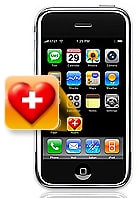Couple of months back, Apple had a big press conference where it stated that it would provide developers more flexibility to create new applications for the iPhone. Much fanfare was made of the announcement, which included a clinical-centric demo of running ePocrates on the iPhone. Seems as though there was a fairly large contingent of the 500,000 or so medical professionals who are using ePocrates that wanted to run it on their iPhone (or had held back purchasing an iPhone till they could get ePocrates on it). This even went so far as a petition drive.
While there are numerous applications being developed for the iPhone, and other smart or cellular phones, it appears that most apps are targeted at physicians. This certainly makes sense as the physician market is well-defined, often their work is highly mobile in nature and they do spend money for devices such as these which make their life easier and facilitate care.
The consumer market for health-centric smart phone apps is far less clear. What types of apps will consumers wish to use on a daily or weekly basis? What applications will be useful for the harried business person who is always on the go? How will such applications be integrated into a broader care provider and information network? Yes, one could go on and on with such questions and honestly, there are few clear answers at this time. But that certainly doesn’t stop companies from developing new apps, throwing them out there and seeing what sticks.
Some time ago I wrote about a unique service from diet.com wherein you simply use SMS to get the nutritional profile of foods you may order at a restaurant. A number of PHR companies are also beginning to offer consumers the ability to access their online PHR via a cell phone and even request that their record be faxed to their doctor’s office. Nice utility but I’d be curious to know just how often it is really used. My guess, once in a Blue Moon.

While I am all for new mobile healthcare-related apps, this one just does not make a lot of sense. It is a rare case indeed where I have ever felt the need to explore a bodily symptom and if I did, I am rarely in a hurry to do so. So why would I need this application sitting on my iPhone? Sure, maybe I want it to just impress friends and family with neat eye candy of the human anatomy, but do not see much utility beyond that which would compel me to use this application on a frequent basis.
Ultimately, successful mobile applications will be those that have a utility that one will want to use on a daily or even weekly basis. If a consumer uses the application less frequently than that, it will be quickly forgotten and/or removed.
Consumers with chronic care issues are a great candidate for mobile applications that can range from medication compliance (programmed alerts to take medication), to linkages via Bluetooth, to a medical device such as a glucose monitor that then uploads data to your PHR (or HealthVault account) for tracking and trending, to the aforementioned weight management solution from diet.com. These are all applications that will be used on a frequent basis and bring enormous utility to the consumer in helping them better manage their health. Even that once in a Blue Moon access to a PHR may prove useful during a doctor’s visit.
Unfortunately, applications like Symptom Navigator do not provide the same level of utility. Sure, they are educational eye candy and can be fun at first, but overtime will fall into disuse. To counter such, A.D.A.M. will need to extend the iPhone Symptom Navigator app far beyond its capabilities today, creating an app that engages the consumer on a daily or weekly basis. What that may look like, I’m unsure of, but the possibility of tying Symptom Navigator to other tools A.D.A.M. has in its product portfolio such as health risk assessments (HRAs) and maybe a partnership or two could result in a more compelling offering for the iPhone than what’s on offer today.




0 Comments
Trackbacks/Pingbacks